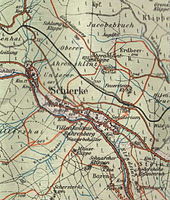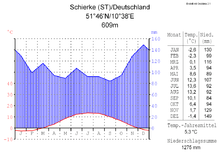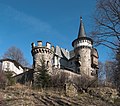Schierke
|
Schierke
City of Wernigerode
|
|
|---|---|
| Coordinates: 51 ° 45 ′ 50 ″ N , 10 ° 39 ′ 53 ″ E | |
| Height : | 617 (610-1141) m |
| Area : | 40.13 km² |
| Residents : | 646 (December 31, 2009) |
| Population density : | 16 inhabitants / km² |
| Incorporation : | July 1, 2009 |
| Postal code : | 38879 |
| Area code : | 039455 |
|
View of Schierke from the Wurmberg
|
|
Schierke is a district of the town of Wernigerode in the Harz district in Saxony-Anhalt and the last town below the Brocken summit. It has been a state-approved climatic health resort since 2002 .
geography
Geographical location
Schierke is located in the Harz Mountains (Hochharz). It borders the Harz National Park to the north and is located in the Harz / Saxony-Anhalt Nature Park, southeast of the Brocken , southwest of the Hohnekamm , north of the Barenberg and east-northeast of the mountain range of Wurmberg , Großem Winterberg and Kleinem Winterberg . It is about 600 to 650 m above sea level. NN in the valley of the Kalten Bode , which is called Elendstal south of the village and is designated as a nature reserve. The south-southeastern neighboring village is misery .
climate
The average air temperature in Schierke is 5.3 ° C, the annual precipitation is 1275 millimeters.
history
Until the 19th century
Schierke was first mentioned as Schircke (she means bare, pure wood in the Harz ) in connection with the establishment of a sawmill on the Kalten Bode in the Sterbetal in the years 1588–1591. Before that, there was already a sawmill in 1506 below the later town in Elend and above, but in the area of the Elbingerode office, there was a smelter near the moor slag. A flood damaged the Schierke ironworks and the Hohenofen on June 8, 1688 and washed away the sawmill. The old church was consecrated in 1691.
"St. Moritz of the North "
On June 20, 1898, Schierke von Wernigerode was connected to the Brocken Railway . On October 4th of the same year the continuation went into operation beyond Schierke to the Brocken. On April 1, 1924 the manor district of Schierke was converted into a rural community of the same name. From the 1890s to the 1940s, Schierke was known as the “St. Moritz of the North ”. At the beginning of the 20th century, around 225,000 people came to the Brocken annually, which can be easily reached in around two hours from Schierke via several hiking trails. Numerous magnificent villas and impressive hotel complexes, such as the Hotel Fürst zu Stolberg or the Kurhotel Barenberger Hof, bear witness to this period. In the former, Queen Juliana (Netherlands) and her prince consort Bernhard zur Lippe-Biesterfeld from Germany are said to have been guests as late as 1936 . Even Paul von Hindenburg is said to have stayed in the 1920s, occasionally there.
"Health resort of the working people"
As early as 1951, Schierke was called the “health resort of the working people” in New Germany . The formerly magnificent hotels were converted into FDGB holiday homes and became increasingly dilapidated. The imposing Hotel Fürst zu Stolberg was renamed Hotel "Heinrich Heine" and renovated in 1968 for the last time. In the 1960s to 1980s, Schierke was only accessible to holidaymakers who were given the "confidence" to "spend their vacation in a health resort directly on the border with Germany" and required a special pass because of the close inner German border . The GDR border troops were located on the current site of the training center of the mechanical engineering and metal trade association . The 7th border company in the 20th border regiment guarded the border section from the Brocken plateau via the Goetheweg station and the Dreieckiger Pfahl boundary stone to the Großer Winterberg. Each one train was stationed for a week on the Brocken and in today's station building of Brockenbahn housed. The Magdeburg district administration of the Ministry for State Security (MfS) of the GDR , the Central Council of the Free German Youth (FDJ) and the National People's Army (NVA) maintained holiday homes in Schierke until 1990.
Development after the fall of the Wall
After the fall of the Wall , the opening of access to the Brocken, which was a restricted military area until 1990, and the reopening of the Brocken Railway initially led to an increase in tourism, which fell sharply in the years after the fall of the Wall - the citizens of the new federal states were now drawn to it to other vacation spots, the Harz lost its tourist importance. In addition, the hotel and catering industry in Schierke no longer lived up to the growing demands. A hotel manager at the time complained, for example, that the guests now complained about "the prevalence of cisterns with cables in the rooms and the lack of modern mixer taps". As a result, most of the larger hotel facilities, including the traditional Hotel Heinrich Heine , had to close soon after the fall of the Wall, and since then the range of accommodation has been largely limited to smaller hotels, guest houses and holiday apartments.
On the other hand, the Brocken is now a tourist magnet again. Schierke is a stop on the Brocken Railway . Many of the listed villas were renovated after the fall of the Wall. On January 13, 2009, the mayor of Schierke, Hans-Jochen Ermisch, and that of Wernigerode, Peter Gaffert , signed the contract for the incorporation into Wernigerode. The incorporation was completed on July 1, 2009. In 2009 the former "Harzland" hotel, which had been badly damaged in a fire in 2005, was demolished, and in 2010 the former "Wurmbergblick" hotel followed.
In 2011, the city of Wernigerode launched an extensive investment program for Schierke. By 2015, around 40 million euros flowed into local development, especially in streets, bridges, parking lots, hotels and sports facilities. The concept of the Berlin architect Wolf-Rüdiger Eisentraut is to first renew the infrastructure. "On the one hand it is about regaining its former attractiveness and on the other hand and much more about meeting the new requirements of the present," the architect writes in his concept. Eisentraut wants to close the center of the Schierke spa park to traffic and replace the street with a promenade based on the model of well-known Baltic Sea resorts. Unused areas are to be used , the range of hotels to be increased up to the luxury class and a spa center to be built. In a second step, a cable car will go from Schierke to the Wurmberg, a bobsleigh run will be built and the old ice rink will be modernized. The core of the measures is a parking garage "Am Winterbergtor", which was built on the outskirts and inaugurated in October 2014. Several parking decks offer space for 715 cars. The place itself will be freed from 300 public parking spaces. A shuttle service for tourists is also planned. The aim is to increase the number of overnight stays, to double jobs and to increase Schierke's population.
In February 2016, the city council of Wernigerode approved the demolition of the listed former Hotel Fürst zu Stolberg to make way for a holiday home complex called Das Schierke-Resort . According to those responsible for the urban properties, the condition of the building was "seriously bad" and the listed building could no longer be saved. Part of the project are 37 wooden houses with around 180 beds, plus a central reception building with reception, utility building, a boiler house and its own district heating network. The facility was officially opened on December 15, 2017 on the same day as the modernized ice rink, now the “ Feuerstein Arena ”.
politics
coat of arms
The coat of arms was awarded on May 5, 1939 by the President of the Province of Saxony .
Blazon : "In gold, a black deer skull with antlers in its sights."
The deer antlers symbolize the "King of the Harz Forest", the predominant game species in the mountain forests of Schierke. Just like the antlers are the crown of the deer, Schierke am Brocken represents the crowning glory of the Harz landscape with its natural beauty and healing climate.
The coat of arms was designed by the Magdeburg State Archives Councilor Otto Korn .
Memorials
- Grave site in the local cemetery for a Romanian whose name is unknown , who was a victim of forced labor during the Second World War .
Attractions
- Brocken , highest mountain in the Harz
- Wurmberg
- Flint cliffs
- Shear cliffs
- Snore cliffs
- "Pharmacy for the Red Foxglove"
- Schierker mountain church
- Town hall Schierke
- Schierke spa gardens
Sport and hiking
The area around Schierke is criss-crossed by many hiking trails , several of which lead to the Brocken or the Wurmberg ( Wurmbergstieg ). From the Schierke train station, a path leads directly to the flint cliff . For winter sports enthusiasts, Schierke has an extensive network of trails and a natural ice rink.
In the first half of the 20th century, Schierke was known for its bobsleigh run , on which German championships were held twice - in 1914 and 1934 . The GDR's first winter sports championships took place here in 1950, for which a special stamp set consisting of two values was published by the GDR Post .
In Schierke there is the “Brockencoaster” summer toboggan run with a sun terrace.
From 1923 a ski jumping hill was built at Eckerloch , which was rebuilt in 1949 and served in 1950 for the GDR championships in ski jumping. At these championships it was named Schanze der Einheit . Because of its location in the restricted border area, it could later be used less and less, fell into disrepair and was dismantled in the 1970s. The hill record held by Werner Lesser is 77.0 meters. The jump at the Eckerloch was built to replace the jump on the southern slope of the Erdbeerkopfes.
In the 1930s, what would later become the Schierker Baude educational and leisure center was built .
The multi-functional arena , which was built for around 9 million euros, was opened in mid-December 2017 .
Schierker Feuerstein
In the resin various herbal liqueurs are produced, of which the Schierker Feuerstein is considered the best known. It was developed by the pharmacist Willy Drube in the “Apotheke zum Roten Fingerhut” and a patent was applied for in 1924 . The liqueur should relieve spa guests in Schierke from stomach problems. It is named after the flint cliffs near Schierke. Willy Drube has in the 1930s with a newspaper competition following grave saying can find for themselves:
- In this pit of the earth
- pharmacist Drube rests.
- Oh wanderer, hurry away from here,
- otherwise he'll come out and drink with you!
The sentence can be read on an open book by his grave.
traffic
Schierke has stations on the Harz narrow-gauge rail network in the central town of Schierke (Schierke station ) and in Drei Annen Hohne ( Drei Annen Hohne station ).
Several regional bus routes operated by the Harz transport company connect Schierke with Wernigerode , Elbingerode and Braunlage .
Schierke is connected to Braunlage via district, state and federal roads and to Wernigerode via district and state roads. The Brockenstrasse runs through Schierke as part of the K 1356 and as the main road and leads from here to the summit of the Brocken.
Personalities
- Maximilian Schumann (1827–1889), Prussian engineer officer, died here
- Johann Veit (1852–1917), gynecologist and obstetrician, died on the way to the Brocken
- Ernst von Stubenrauch (1853–1909), lawyer, local politician and district administrator, died in the village
- Heinrich Clausen (1879–1966), local politician, publisher, photographer and restaurateur, lived in Schierke for a long time and was temporarily mayor of the place
- Willy Drube (1880–1952), pharmacist and manufacturer of the " Schierker Feuerstein "
- Wilhelm Obendiek (1885–1955), mayor
- Rudolf Agsten (1926–2008), politician (LDPD), headed the state party school in Schierke from 1947 to 1948
- Lutz Meier (1948–1972), lieutenant in the border troops, lost his life on the inner-German border
- Jens Baxmann (* 1985), ice hockey player, began his career here
Others
Johann Wolfgang von Goethe visited Schierke in 1784 as part of a geological excursion and relocated a scene in Faust in the area. The scene “Walpurgis Night” has the subtitle: “Harz Mountains, area of Schierke and misery”.
The professional association for wood and metal maintains a large training center in Schierke .
literature
- Eduard Jacobs : Schierke. History of the former hut - now health resort, Wernigerode 1896.
- Harzklub Zweigverein Schierke, guide through Schierke and the surrounding area. High-altitude health resort next to the Brocken, Wernigerode 1901.
- Erich Wziontek: Schierke. History, nature and life, Schierke 1911.
- Ingrid Hintze: Schierke am Brocken, a journey through time, a place in transition, a health resort. Self published in 2009.
Web links
- Official website of the Schierke district
- Integrated site development concept for Schierke on the Wernigerode website (PDF; 196 kB)
Individual evidence
- ↑ Specification of health resorts and recreational areas in Saxony-Anhalt (as of March 2017) ( Memento of the original from December 30, 2017 in the Internet Archive ) Info: The archive link was inserted automatically and has not yet been checked. Please check the original and archive link according to the instructions and then remove this notice.
- ^ German Weather Service, normal period 1961-1990
- ↑ Administrative region of Magdeburg (Ed.): Official Gazette of the Government of Magdeburg . 1921, ZDB -ID 3766-7 , p. 61 .
- ^ Sabine Gorsemann, Christian Kaiser: Dumont travel pocket book resin; P. 146
- ↑ a b Schierke am Brocken: The East Harz is making its comeback Der Spiegel from February 3, 2004
- ↑ Pictures of the hotel, renamed FDGB Erholungsheim Hermann Duncker during the GDR, on a private website ( memento of the original from March 4, 2016 in the Internet Archive ) Info: The archive link was inserted automatically and has not yet been checked. Please check the original and archive link according to the instructions and then remove this notice.
- ↑ a b Proleten in den Keller , Der Spiegel from June 15, 1950
- ^ Championships in Schierke opened New Germany on January 13, 1951
- ↑ a b "A feudal luxury hotel" , Neue Nordhäuser Zeitung of November 13, 2012
- ↑ In the direction of misery, please only on foot. Excerpt from a leaflet for Schierke vacationers, printed in Spiegel from October 31, 1977
- ↑ Schierke and Wernigerode are happy . MDR Info, January 13, 2009
- ↑ StBA: Area changes from January 2nd to December 31st, 2009
- ^ Katrin Schröder, Volksstimme Magdeburg: Holiday park revives Schierker fallow. Retrieved April 19, 2020 .
- ^ Ivonne Sielaff, Volksstimme Magdeburg: Demolition of the Wurmberg view - signal for departure for Schierke. Retrieved April 19, 2020 .
- ↑ New multi-storey car park in Schierke - All public parking spaces are disappearing Mitteldeutsche Zeitung of October 24, 2014
- ↑ "St. Moritz des Nordens ”- Millions are to make Schierke a“ pearl ”again ( Memento of the original from April 2, 2015 in the Internet Archive ) Info: The archive link was inserted automatically and has not yet been checked. Please check the original and archive link according to the instructions and then remove this notice. , Lausitzer Rundschau from April 4, 2011
- ↑ Green light for new Heine houses , Volksstimme from February 12, 2016
- ↑ Last walk through the former grand hotel in Schierke MDR Saxony-Anhalt on February 27, 2016, accessed on February 27, 2016
- ↑ Ivonne Sielaff, Regina Urbat: A historic day for Schierke. In: volksstimme.de. December 15, 2017. Retrieved December 27, 2017 .
- ^ History of the "Schanze der Einheit" at www.schisprungschanzen.com, last accessed on March 1, 2013












